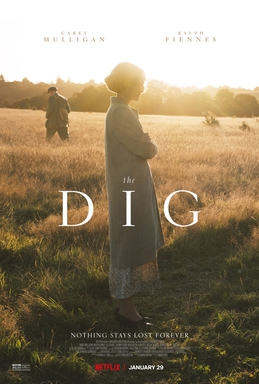‘The Dig’ captures a lyrical thing…Edith Pretty’s faith, hope and charity

The film’s official poster. Source WP:NFCC#4
/ FAITH, HOPE…

“Some people say there is a God; others say there is no God; the truth probably lies somewhere in between”
– W. B. Yeats
In the Before Times, when we could go to the British Museum and gawk at the Rosetta Stone and the Sphinx of Taharqa, chances were we would also take in the Sutton Hoo burial ship, a permanent display.
The pandemic has put paid to all of that. Thankfully, ‘The Dig’, a new movie on Netflix, offers the chance to go on travelling – back in time and in a charming part of England.
It takes us to Sutton Hoo estate, once in the kingdom of East Anglia, and now in Suffolk. What was formerly the kingdom of East Anglia would now be in Suffolk and Norfolk.
The estate had several burial mounds on it (that’s why it was called “Hoo”) and Edith Pretty, the widow who owned it, decided to have it excavated. That was in 1939, against the backdrop of a looming war (as well as Mrs Pretty’s own worsening health).
The results of the excavation were quite spectacular and there is an abundance of writing about the find. (Click here to read Sue Brunning, the British Museum’s curator of Early Medieval European Collections, describe in 2019 how the Sutton Hoo excavation led her to this career path.)
And there’s lots been written about how closely (or not) the film tracks the events that occurred in a quiet corner of England 82 years ago. (Click here for History vs Hollywood’s take on the historical accuracy of ‘The Dig’.)
It’s a film based on a book, which is based on true events, so no one should take it as 100 per cent true.
But I think it does an excellent job in conveying an impression of a certain time and way of being – great wealth, great generosity, basic civic sense. This is not to wax lyrical about the past, investing it with glory and goodness just because it’s gone. There are plenty of disagreeable people around in ‘The Dig’, not least, the archaeologist sent down to Sutton Hoo by the British Museum. He is shown as rather pompous in the film, though not, I believe, in real life.
And back then too, as at any time, promises were broken, lies were told.
But there is something curiously touching about this story and I think it’s because of one woman’s faith and hope and charity.

